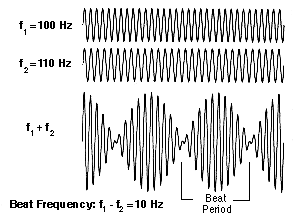|
|
If two TONEs are about 15 Hertz or less apart, INTERFERENCE will result from their similar though not exactly identical frequencies. Gradually they will move out of PHASE until at 180° destructive interference results, producing diminished loudness. When they move back into phase, constructive interference will produce increased loudness. Thus, beats are a form of AMPLITUDE MODULATION. As two frequencies are brought closer together, the beats will gradually slow down and disappear when they become identical.
See: CANCELLATION, HETERODYNE, JUST INTONATION, LAW OF SUPERPOSITION, PHASE-SHIFT. Compare: PHASING, PULSE.

The superposition of two sine waves producing beats.
![]() Sound
Example: Beats produced by 100 and 110
Hz, with the higher tone gradually reduced to 100 Hz causing the
beats to slow down and disappear.
Sound
Example: Beats produced by 100 and 110
Hz, with the higher tone gradually reduced to 100 Hz causing the
beats to slow down and disappear.
Beats recur at a rate equal to the difference between the two frequencies, called the beat frequency. Thus the beat frequency produced by 500 Hz and 496 Hz is 4 Hz. Piano tuners use the phenomenon of beats when bringing strings into UNISON.
See: TUNING. Compare: GRAIN, TREMOLO, VIBRATO.
Beats arising from the mistuned unison are called first-order beats, and are both an acoustic and psychoacoustic phenomenon. Beats also may be heard between pure tones that are nearly an OCTAVE, FIFTH or FOURTH apart. These are called secondary or second-order beats, where the beat frequency is equal to the frequency difference e between the upper tone and the exact interval for the octave, 2e for the fifth and 3e for the fourth. However, no amplitude modulation is present, and the beating results from effects of neural processing.
Although two tones with a constant PHASE DIFFERENCE sound the same, independent of the degree of phase difference, in the case of secondary beats, the phase difference is constantly changing, producing a changing WAVEFORM, as can be seen in the diagram below. The phenomenon occurs only where the lower tone is below about 1500 Hz. However, it also occurs with DICHOTIC listening where it is called binaural beats and where the phase difference is interpreted as in BINAURAL HEARING, i.e. as a spatial difference. See also: CRITICAL BANDWIDTH.

Wave pattern showing second-order beats created by a mistuned octave. Note the shifting phase pattern with no change in total amplitude.
![]() Sound
Example: Second-order beats between 100
and 201 Hz.
Sound
Example: Second-order beats between 100
and 201 Hz.
![]() Sound
Example: Second order beats presented
dichotically between 200 and 401 Hz (to be listened to via
headphones).
Sound
Example: Second order beats presented
dichotically between 200 and 401 Hz (to be listened to via
headphones).
home